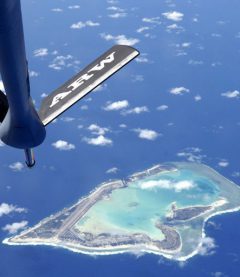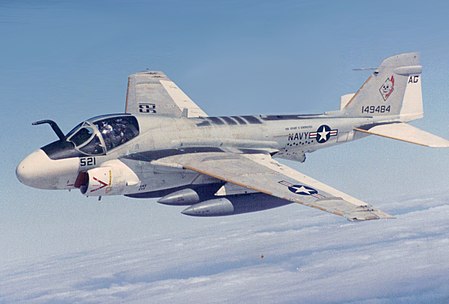Introduction
The Grumman A-6 Intruder was an all-weather medium attack aircraft used by the United States Marine Corp (USMC) and United States Navy (USN). The Intruder was a replacement for the piston driven Douglas A-1 Skyraideer.
When the A-6 was scheduled for replacement, the strike mission was taken over by the Grumman F-14 Tomcat. The first A-6 flight was on 19 April 1960. The USN retired the last active Intruder on 28 February 1997. Grumman Aircraft built 693 A-6 Intruders.
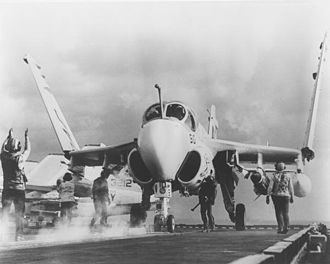
Design and Development
In 1955, the USN needed a new all-weather, jet attack fighter to replace the A-1 Skyraider which did an excellent job in Korea. The recquestion process with any government usually follows this pattern, after abundant studies, then a “request for proposal” which was issued in February 1957. The following companies entered a bid for the contract:
- Bell
- Boeing
- Douglas
- Grumman
- Lockheed
- Martin
- North American
On 02 January 1958, the USN announced that Grumman Aircraft was the winner of the proposed contract to build the A-6. The A-6 design team was led by Lawrence Mead, who later help design the Grumman F-14 Tomcat and the Apollo Lunar Excursion Module or LEM.
It was the beginning of the jet fighter age to have sophisticated avionics such as multiple computers on board the aircraft. As Lawrence helped bring this about in the A-6 The first prototype was called YA2F-1, without radar, navigational and attack avionics. The firs prototype flew in April 1960 and the second prototype flew on 28 July 1960.
The first two prototypes had handling problems with the speed brakes (speed bakes or spoilers extend upwards to slow the aircraft down quickly) that were mounted on the rear fuselage. The third prototype had split-hinge speed brakes on the aircraft’s wingtips. This resolved the handling problem and future production aircraft were made without the fuselage speed brakes.
The aircraft that had already been built had the fuselage speed brakes bolted down or removed completely. The first prototypes had jet nozzles that swivel downwards for shorter take-offs, however that feature did not work too well and were removed during test flight and not used on production aircraft.
The cockpit held two crew members side by side. The pilot seat was on the left side, while the bombardier/navigator sat on the right and slightly lower the pilot.
The right seater had a CRT console which showed the landscape for low flight for surprise attack. The wing was designed to provide good maneuverability with a good size bomb load.
To help aid any speed brake problems, a “Deceleron” as it was called was placed on top of each wing in the form of a panel. When one panel was raided, the other was down or flat on the wing. This completely alleviated the speed brake or spoiler problem.
The Intruder had a high degree of sophisticated electronics for its day. It did require a heavy maintenance schedule both routine and repair. Litton Industries devised a diagnostic system to help spot and pin point malfunctioning equipment which help reduce maintenance costs per flying hour.
The A-6 Intruder was built to carry nuclear weapons as well as conventional ones. There was a procedure called “over the shoulder bomb launch” in which the Intruder would fly at low levels to surprise the target.
As the computer told them at a certain point to climb steeply to a certain altitude then release the weapon which would be tossed upwards and outwards while the aircraft would at full power continue its climb to a designated altitude heal over and fly in the opposite direction it had come from at top speed. When the weapon exploded, the A-6 should be several miles away from the targeted area and ahead of the nuclear shock wave.
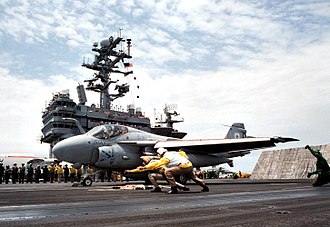 Operational History
Operational History
Viewnam War
The USN and USMC received the A-6 Intruder in February 1963 in squadron strength as their principal all-weather, night attack aircraft. The aircraft entered the Vietnam War shortly after achieving squadron strength. The A-6s ability to fly in all types of weather made it an invaluable as did its long range.
However because it did fly at low levels, it was subject to anti-aircraft and small arms fire. In the eight years is served in Vietnam, the USN and USMC lost 84 aircraft. There were 56 A-6s lost to ground fire and anti-aircraft,10 to surface-to-air missiles (SAMs) and 16 lost for operational reasons.
The last Intruder lost in the Vietnam War was on 24 January 1973 while providing close air support. The two crew members ejected and were picked up by USN helicopters.
Mid-East Action
Some other operations including support of a Multinational Force in Lebanon, Operation El Dorado in Libya from 1983-1986, the Gulf War in 1991 in which the USN and USMC flew over 4,700 sorties in close air support, destroying enemy air defense, attacking Iraqi naval unites and other strategic targets with “laser bombs”
The USN A-6s operated form the USS Saratoga, USS John Kennedy, USS Midway, USS Ranger, USS America and USS Theodore Roosevelt. After the War, the A-6 flew patrols in the “”no-fly”” zones in Iraq. There 3 A-6s lost from anti-aircraft and SAMs (Surface-to-Air Missiles) during the Gulf War.
The Final Years
The A-6 was extended a few more years past the original retirement date in the late 1980s. Finally especially avionic equipped F-14 Tomcat started replacing the aging Intruders. Then the USN F/A-18 Superhornet and the USMC F/A Hornet replaced the F-14 Tomcat. The last Intruder was retired 28 February 1997.
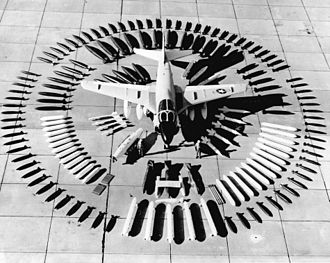
Where you can see the A-6 Intruder
#147867 Allegheny Arms & Armory Museum Smethport, Pennsylvania
#151782 USS Midway Museum San Diego, California
#152603 Richmond Municipal Airport Richmond, Indiana
#152907 Whidbey Island NAS Oak Harbor, Washington
#152935 Empire State Aerosciences Museum Glenville, New York
#154612 Palm Springs Air Museum Pal Springs, California
#158532 USS Lexington Museum Corpus Christi, Texas
#160995 Yanks Air Museum Chino, California
#158794 Museum of flight Seattle, Washington
#155713 Pima Air and Space Museum Tucson, Arizona
This is Just a Partial List of A-6 Intruders on Display. Check with Your Local Air Museum for More Information
Tech Specs for the A-6 Intruder
Wingspan: 53 ft 0 in
Length: 54 ft 9 in
Height: 16 ft 2 in
Weight: 26,660 lbs (empty) ; 60,400 Maximum Take-off Weight
Max Speed: 560 mph; Cruise 412 mph
Ceiling: 42400 ft
Range: 2,818mi (ferry)
Engine: 2/Pratt & Whitney J52-P8B turbojets rated at 9,300 lbs of thrust
Crew: 2
THANKS FOR READING! I HOPE THIS WAS INFORMATIVE!
